![]()
![]()
![]()
Use LEFT and RIGHT arrow keys to navigate between flashcards;
Use UP and DOWN arrow keys to flip the card;
H to show hint;
A reads text to speech;
64 Cards in this Set
- Front
- Back
|
Pedigree Analysis |
The construction of family trees and their use to follow the transmission of genetic traits in families. It is the basic method of studying the inheritance of traits in humans. |
|
|
Organelles |
Cytoplasmic structure that have a specialized function |
|
|
Ribosomes |
Cytoplasmic particles that aid in the production of proteins |
|
|
Golgi Complex |
Membranous organelles composed of a series of flattened sacs. They sort, modify, and packaged proteins synthesized in the ER |
|
|
Lysosome |
Membrane enclosed organelles that contain digestive enzymes |
|
|
Mitochondria |
Membrane-bound organelles, present in the cytoplasm of all eukaryotic cells, that are the sites of energy production within the cells |
|
|
Sex chromosomes |
Chromosomes that determine sex of an organism; carry genes for other characteristics |
|
|
Autosomes |
All the other chromosomes in an organism |
|
|
Cytokinesis |
Process during cell division where the cytoplasm divides |
|
|
Centromere |
Two chromatids of chromosome are attached by this structure |
|
|
Gene |
Segment of DNA that codes for a protein or RNA molecule |
|
|
Haploid |
Cell containing only one set of chromosomes |
|
|
Chromatids |
The two exact copies of DNA that make up each chromosome |
|
|
Nucleotide |
The basic building block of DNA and RNA. Each nucleotide consists of a base, phosphate, and sugar |
|
|
Purine |
A class of double ring organic bases found in nucleic acids; A and G |
|
|
Pyrimidine |
Class of single ringed organic bases found in nucleic acids; T and C |
|
|
Codon |
Triplets of nucleotides in mRNA that encode the info for a specific amino acid in a protein |
|
|
Transcription |
Info in a specific region of DNA (a gene) is copied into mRNA |
|
|
Sex-Linked |
Gene is found on the X or Y chromosome |
|
|
Missense Mutation |
Single nucleotide change in DNA that leads to substituting one amino acid for another |
|
|
Sense Mutation |
Produce longer than normal proteins by changing a stop codon to a codon that codes for an amino acid |
|
|
Nonsense Mutation |
A codon that codes for an amino acid is substituted for one that codes for a stop codon |
|
|
Silent Mutation |
Some amino acids have more than one codon; has no effect |
|
|
Types of Mutations? |
Point Mutations (substitution) Frameshift mutations (insertions and deletions) |
|
|
Deletion Mutation |
Nitrogen base is deleted |
|
|
Insertion Mutation |
Nitrogen base is added |
|
|
Karyotype |
Chromosomes are arranged in pairs according to size and centromere location |
|
|
Meiosis |
The process of cell division during which one cycle of chromosomal replication is followed by two successive cell divisions to produce 4 haploid cells |
|
|
Mitosis |
Form of cell division that produces two cells each of which has the same complement of chromosomes as the parent cells |
|
|
Cell cycle |
Interphase, prophase, metaphase, anaphase, telophase |
|
|
Allele |
One of the possible alternative forms of a gene usually distinguished from one other alleles by its phenotypic effects |
|
|
X-Linked |
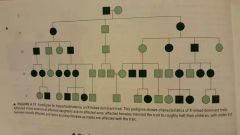
The pattern of inheritance that results from genes located on the X chromosome |
|
|
Y-chromosome inheritance pattern |
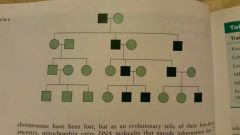
The pattern of inheritance that results from genes located only on the Y chromosome |
|
|
Metacentric |
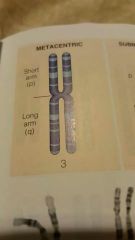
Describes a chromosome that has a centrally placed centromere |
|
|
Submetacentric |
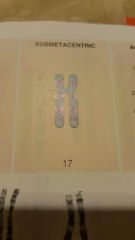
Describes the chromosome whose centromere is placed closer to one end than the other |
|
|
Acrocentric |
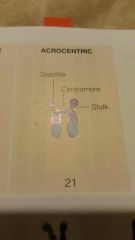
Describe the chromosome whose centromere is place very close to, but not at, one end |
|
|
Arm q |
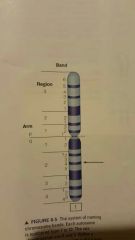
Long arm on chromosome |
|
|
Arm p |
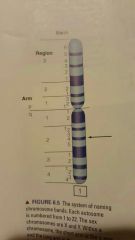
Short arm on chromosome |
|
|
Region |
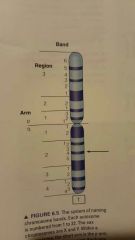
Broken down on chromosome |
|
|
Band |

Broken down from region on chromosome |
|
|
Polyploidy |
A chromosomal number that is a multiple of the number haploid chromosomal set |
|
|
Aneuploidy |
A chromosomal number that is not an exact multiple of the haploid set |
|
|
Monosomy |
a condition in which one member of a chromosomal pair is missing; having one less than the diploid number (2n-1) |
|
|
Trisomy |
A condition in which one chromosome is present in three copies, whereas all others are diploid; having one more than the diploid number (2n+1) |
|
|
Nondisjunction |
The failure of homologous chromosomes to separate properly during meiosis or mitosis |
|
|
Nucleotide |
The basic building block of DNA and RNA. Nucleotide consists of a base, a phosphate, and a sugar |
|
|
Pentose sugar |
A 5 carbon sugar molecule found in nucleic acid |
|
|
Phosphate group |
A compound contain phosphorus chemically bonded to four oxygen molecules |
|
|
DNA polymerase |

An enzyme that catalyzes the synthesis of DNA using a template DNA strand and nucleotides |
|
|
Messenger RNA |
A single-stranded complimentary copy of the nucleotide sequence in a gene |
|
|
transcription |
Transfer of genetic information from the base sequence of DNA to the base sequence of RNA, meditated by RNA synthesis |
|
|
Translation |
Conversion of information included in the nucleotide sequence of an mRNA molecule into the linear sequence of amino acids in protein |
|
|
Production of polypeptide |
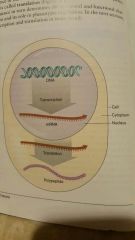
From DNA to transcription into mRNA from mRNA to translation into a polypeptide |
|
|
Transfer RNA |
A small RNA molecule that contains a binding site for a specific type of amino acid and has a three base segment known as an anticodon that recognizes a specific base sequence in messenger RNA |
|
|
Ribosomal RNA |
RNA molecules that form part of the ribosome |
|
|
Anticodon |
A group of three nucleotides in a tRNA molecule that pairs with a complementary sequence (known as a codon) in a mRNA molecule |
|
|
Protein folding |
Once polypeptide fold into three dimensional shape, become chemically modified, and become functional, they are called proteins |
|
|
Radiation |
The process by which a magnetic energy travels through space or a medium such as air |
|
|
Ionizing radiation |
Radiation that produces ions during interaction with other matter, including molecules in cells |
|
|
Background radiation |
Radiation in the environment that contributes to radiation exposure |
|
|
Nucleotide substitutions |
Mutations that involve the placing of one or more nucleotides in the DNA molecule with other nucleotides |
|
|
Frameshift mutations |
mutational event in which a number of bases (other than multiples of 3) are added to or removed from DNA, causing a shift in the codon reading frame |
|
|
Autosomal doninant pattern of inheritance |
One mutated copy of the gene in each cell is sufficient for a person to be affected by an autosomal dominant disorder. |
|
|
Autosomal recessive pattern of inheritance |
Two mutated copies of the gene are present in each cell when a person has an autosomal recessive disorder. |

